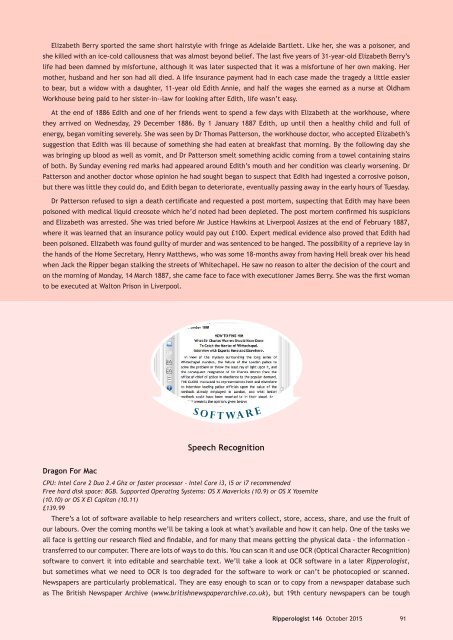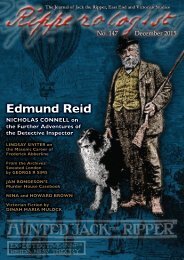GEORGE HUTCHINSON
orxwju5
orxwju5
Create successful ePaper yourself
Turn your PDF publications into a flip-book with our unique Google optimized e-Paper software.
Elizabeth Berry sported the same short hairstyle with fringe as Adelaide Bartlett. Like her, she was a poisoner, and<br />
she killed with an ice-cold callousness that was almost beyond belief. The last five years of 31-year-old Elizabeth Berry’s<br />
life had been damned by misfortune, although it was later suspected that it was a misfortune of her own making. Her<br />
mother, husband and her son had all died. A life insurance payment had in each case made the tragedy a little easier<br />
to bear, but a widow with a daughter, 11-year old Edith Annie, and half the wages she earned as a nurse at Oldham<br />
Workhouse being paid to her sister-in--law for looking after Edith, life wasn’t easy.<br />
At the end of 1886 Edith and one of her friends went to spend a few days with Elizabeth at the workhouse, where<br />
they arrived on Wednesday, 29 December 1886. By 1 January 1887 Edith, up until then a healthy child and full of<br />
energy, began vomiting severely. She was seen by Dr Thomas Patterson, the workhouse doctor, who accepted Elizabeth’s<br />
suggestion that Edith was ill because of something she had eaten at breakfast that morning. By the following day she<br />
was bringing up blood as well as vomit, and Dr Patterson smelt something acidic coming from a towel containing stains<br />
of both. By Sunday evening red marks had appeared around Edith’s mouth and her condition was clearly worsening. Dr<br />
Patterson and another doctor whose opinion he had sought began to suspect that Edith had ingested a corrosive poison,<br />
but there was little they could do, and Edith began to deteriorate, eventually passing away in the early hours of Tuesday.<br />
Dr Patterson refused to sign a death certificate and requested a post mortem, suspecting that Edith may have been<br />
poisoned with medical liquid creosote which he’d noted had been depleted. The post mortem confirmed his suspicions<br />
and Elizabeth was arrested. She was tried before Mr Justice Hawkins at Liverpool Assizes at the end of February 1887,<br />
where it was learned that an insurance policy would pay out £100. Expert medical evidence also proved that Edith had<br />
been poisoned. Elizabeth was found guilty of murder and was sentenced to be hanged. The possibility of a reprieve lay in<br />
the hands of the Home Secretary, Henry Matthews, who was some 18-months away from having Hell break over his head<br />
when Jack the Ripper began stalking the streets of Whitechapel. He saw no reason to alter the decision of the court and<br />
on the morning of Monday, 14 March 1887, she came face to face with executioner James Berry. She was the first woman<br />
to be executed at Walton Prison in Liverpool.<br />
S O F T WA R E<br />
Speech Recognition<br />
Dragon For Mac<br />
CPU: Intel Core 2 Duo 2.4 Ghz or faster processor - Intel Core i3, i5 or i7 recommended<br />
Free hard disk space: 8GB. Supported Operating Systems: OS X Mavericks (10.9) or OS X Yosemite<br />
(10.10) or OS X El Capitan (10.11)<br />
£139.99<br />
There’s a lot of software available to help researchers and writers collect, store, access, share, and use the fruit of<br />
our labours. Over the coming months we’ll be taking a look at what’s available and how it can help. One of the tasks we<br />
all face is getting our research filed and findable, and for many that means getting the physical data - the information -<br />
transferred to our computer. There are lots of ways to do this. You can scan it and use OCR (Optical Character Recognition)<br />
software to convert it into editable and searchable text. We’ll take a look at OCR software in a later Ripperologist,<br />
but sometimes what we need to OCR is too degraded for the software to work or can’t be photocopied or scanned.<br />
Newspapers are particularly problematical. They are easy enough to scan or to copy from a newspaper database such<br />
as The British Newspaper Archive (www.britishnewspaperarchive.co.uk), but 19th century newspapers can be tough<br />
Ripperologist 146 October 2015 91




